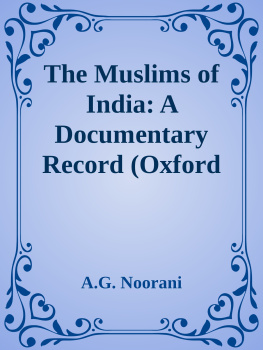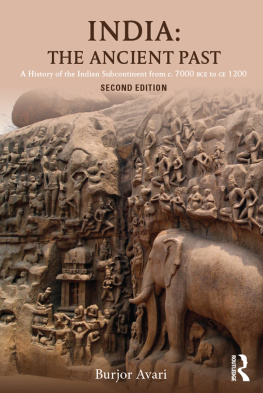British Museum

Girl Musicians and Dancer. Mural Painting. Bagh. 7th century
Frontispiece

NO part of this book may be reproduced, for any reason, by any means, including any method of photographic reproduction, without the permission of the publisher.
First published in 1954
A LL R IGHTS R ESERVED
This edition is published by arrangement with
The Macmillan Co., New York
First Evergreen Edition 1959
Sixteenth Printing
MANUFACTURED IN THE UNITED STATES OF AMERICA
DISTRIBUTED BY RANDOM HOUSE, INC., NEW YORK
ACLS Humanities E-Book handheld edition 2011
ISBN: 978-1-59740-852-3
HEB02419.0001.001
IN MEMORY OF
MY MOTHER
WHO DIED WHILE THIS WORK
WAS IN PROGRESS
[Page vi]
I shall not now speak of the knowledge of the Hindus, of their subtle discoveries in the science of astronomy-discoveries even more ingenious than those of the Greeks and Babylonians-of their rational system of mathematics, or of their method of calculation which no words can praise strongly enoughI mean the system using nine symbols. If these things were known by the people who think that they alone have mastered the sciences because they speak Greek they would perhaps be convinced, though a little late in the day, that other folk, not only Greeks, but men of a different tongue, know something as well as they.
The Syrian astronomer-monk S EVERUS S EBOKHT (writing A.D. 662).
PREFACE
[Page vii]
T HIS book has been written to interpret ancient Indian civilization, as I understand it, to the ordinary Western reader who has little knowledge of the subject, but some interest in it. The three nations of the Indian Sub-continent, since the momentous days of 1947 when they gained complete independence, have been playing an evergrowing part in the affairs of the world, and there is perhaps room for a new outline of their ancient culture, to replace the many excellent works now out of print, and to further our understanding of the civilization of these new states in the contemporary world.
As this book is intended for the general reader I have tried, as far as possible, to leave nothing unexplained. And as I believe that civilization is more than religion and art I have tried, however briefly, to cover all aspects of Indian life and thought. Though primarily intended for Westerners I hope that the book may be of some interest to Indian, Pakistani and Sinhalese readers also, as the interpretation of a friendly mleccha, who has great love and respect for the civilizations of their lands, and many friends among the descendants of the people whose culture he studies. The work may also be of help to students who are embarking on a course of serious Indological study; for their benefit I have included detailed bibliographies and appendices. But, for the ordinary reader, the work is cumbersome enough, and therefore I have not given references for every statement. I have tried to reduce Sanskrit terms to a minimum, but the reader without background knowledge will find definitions of all Indian words used in the text in the index, which also serves as a glossary.
Sanskrit, Prkrit and Pli words are transliterated according to the standard system at present used by Indologists; this, with its plethora of diacritic marks, may at first seem irritating, but it is the only sound method of expressing the original spelling, and gives a clear idea of the correct pronunciation. Modern Indian proper names are generally given in the most usual spelling Throughout this work the word India is of course used in its geographical sense, and includes Pakistan. Though very inadequately, I have tried to include in the scope of this survey Ceylon, whose culture owed much to India, but developed many individual features of its own.
The translations, except where specified, are my own. I lay no claim to great literary merit for them, and have not been able to reproduce the untranslatable incantation of the originals. In most cases they are not literal translations, since the character of Indian classical languages is so unlike that of English that literal translations are at the best dull and at the worst positively ludicrous. In places I have taken some liberty with the originals, in order to make their purport clearer to the Western reader, but in all cases I have tried to give an honest interpretation of the intentions of their authors, as I understand them.
In the course of writing this book I have asked the advice of several friends and colleagues, and have also received their encouragement and help in other respects. I must specially thank (in alphabetical order) Mr. F. R. Allchin, Dr. A. A. Bake, Dr. L. D. Barnett (my respected teacher, whose Antiquities of India, written over forty years ago, has to some extent served as a model for this book), Professor J. Brough (who first suggested that I should write this book), Mrs. Devahuti, Professor A. T. Hatto, Mr. J. R. Marr (for translations on p. 464ff), Dr. A. K. Narain, Professor C. H. Philips, Mr. P. Rawson, Mr. C. A. Rylands, and Dr. Arthur Waley (for translations on p. 477f). I would also thank the numerous institutions and individuals who have kindly allowed me to reproduce illustrations of which they hold the copyright, and whose names are recorded above each plate; and the Librarian and Staff of the Library of the School of Oriental and African Studies, University of London, for their courtsey and help. Finally, I am greatly indebted to my wife for much encouragement.
A. L. BASHAM
London, 1953
Except in a few cases where, to avoid confusion, I have substituted a for the more usual u, e.g. Panjb, Satlej, etc.
Endpapers not included in this edition.
At the time of going to press it has not been possible to trace the present owners of the copyright of the following c: plates XVIb, XIXc, XXa, XLIIb, LIX. They are asked to communicate with the Publisher.
CONTENTS
ILLUSTRATIONS
PLATES
[Page xiii]
I.
II.
III.
IV. Pioneers of Indology
(a) Sir William Jones
V.
VI.
VII.
VIII.
IX.
X.
XI.
XII.
[Page xiv] XIII.
XIV.
XV. Kailsantha Rock-temple, Ellor
(a) General View
XVI.
XVII.
XVIII.
XIX.
XX.
XXI.
XXII.
XXIII. () Capitals of Mauryan Pillars
(
XXIV.
XXV.
XXVI.
XXVII.
XXVIII.
XXIX.
XXX.
XXXI.
[Page xv] XXXII.
XXXIII.
XXXIV.
XXXV.
XXXVI.
XXXVII. Gupta Sculpture
(a) Srya, Pway, Gwlior
XXXVIII.
XXXIX.
XL.
XLIII.
XLIV.
XLV.
XLVI.
XLVII.
XLVIII.
XLIX.
L.
LI.
LII.
LIII. (a) iva Dancing, Oriss
(b) Brhaspati, Oriss
LIV.
LV.
LVI.
LVII.
LVIII.
[Page xvi] LIX.
LX.
LXI.
LXII.
LXIII.
LXIV.
LXV.
LXVI.
LXVII.
LXVIII.
LXIX.
LXX.
LXXI.
LXXII.
LXXIII.
LXXIV.
LXXV.
LXXVI.
LXXVII.
LXXVIII.
LXXIX.
LXXX. Elephant and Rider in Procession. Bagh
(
Next page













